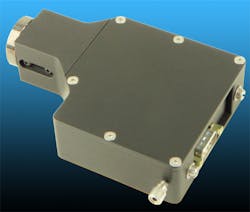ASI autofocus system works with most normal microscope objectives
The Continuous Reflective Interface Sample Placement (CRISP) autofocus system is designed to compensate for thermal and other factors that may cause a sample to drift out of focus over time. It can also maintain a particular focal point while scanning a sample in X-Y. It mounts onto a standard C-mount port and works with most normal microscope objectives.
Applied Scientific Instrumentation
Eugene, OR
[email protected]
More Products
-----
PRESS RELEASE
CRISP Autofocus System
The Continuous Reflective Interface Sample Placement (CRISP) projects the image of a mask illuminated with an IR LED into the sample plane. Only one half of the objective pupil is illuminated. This means that the point spread function of the objective is highly skewed, so that the reflected image of the mask will move laterally as focus is changed. CRISP detects this lateral motion of the LED image to obtain a focus error that is used to close the focus positioning loop.
The CRISP mounts onto any microscope's standard C-mount port and maintains ideal focus for days.
